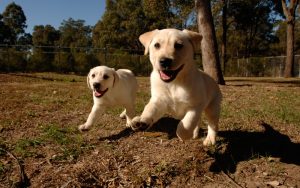Consistent, positive training is an important part of raising a puppy. Caroline Zambrano explains how to teach your puppy his first tricks to become a well-behaved canine citizen.
Training your puppy from a young age is important. After all, puppies don’t come pre-programmed! With consistent, positive training, your new furry member of the family can adjust well to living in the human world, which is filled with expectations.
Louise Ginman, one of Australia’s leading dog trainers and president of the Association of Pet Dog Trainers Australia, says training is a way to communicate with our dogs how we want them to live with us in our human world. “If we leave puppies to their devices, they will do what is fun to do, such as chewing or digging. It is natural for them to interact with their siblings by grabbing their ears, pouncing on them or play biting using their sharp puppy teeth. But when they do that to us or children in the home, we find it unacceptable.”
Why is positive reinforcement a better method?
We can teach our puppies how we expect them to behave via positive reinforcement methods, which helps build a good relationship between you and your puppy, as well as other dogs in the family, says Louise, who’s also a puppy class instructor and author of The Art of Introducing Dogs: A Guide for Conducting Dog-to-Dog Introductions.
“Often new owners spend a lot of time correcting puppies with ‘no, don’t do that’ or worse. Rather than living in a world of constant corrections, it’s better for your puppy to tell them what we want them to do instead,” she says. “Start rewarding the behaviours that we like, which makes future behaviours that we want more likely to happen. The more we reward, the more we get the behaviour. And the more we enjoy their company, the better our relationship gets with them.”
Studies have shown that physical punishment can damage the dog and owner relationship, and often creates more anxious and more aggressive behaviours, Louise adds.

Making training fun
Puppy training requires a long-term commitment but it doesn’t have to be boring, Louise says. “We can make training fun and beneficial by teaching your puppy ‘tricks’ using positive reinforcement.” Louise shares some fun and useful tricks to teach your puppy:
Trick #1: Name recognition
This trick teaches your puppy his/her name by pairing the name with giving a treat.
Benefits: Teaching your puppy to recognise his/ her name is important. This exercise not only teaches puppies to give you attention when they hear their name, but also helps to keep them out of trouble. Name recognition training creates a positive association with your dog’s name and therefore increases their response rate when they hear their name.
Training instructions: Say your puppy’s name and follow immediately with a treat. Practice once or twice daily for seven days with 10 treats.
Trick #2: Treats in turns
This trick works for those who have more than one dog at home and after your dogs has Trick #1 down pat! Your dogs will sit near each other and take turns taking a treat when you call their names.
Benefits: This is a great relationship-building exercise between your dogs, particularly if you have an older dog at home already when your puppy arrives who may not be over the moon about having a new four-legged member of the family. This trick also helps your dogs build self-control.
Training instructions: Have your dogs sitting at a safe distance beside each other and feed each a treat when you call their name. Slowly decrease the distance between them over time until they can sit within 50cms of each other while doing the exercise. Remember, they only get a treat when they hear their name!
Want to teach your pup more tricks? Get your paws on a copy of PETS Magazine here.


Leave a Reply